headlamp CADILLAC CTS 2008 2.G Owner's Manual
[x] Cancel search | Manufacturer: CADILLAC, Model Year: 2008, Model line: CTS, Model: CADILLAC CTS 2008 2.GPages: 490, PDF Size: 2.59 MB
Page 282 of 490
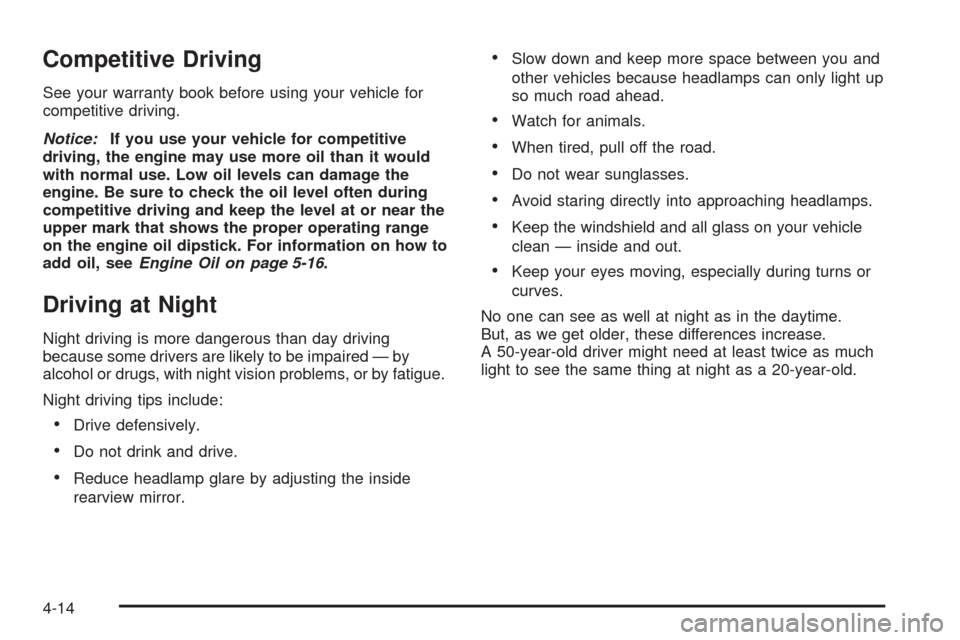
Competitive Driving
See your warranty book before using your vehicle for
competitive driving.
Notice:If you use your vehicle for competitive
driving, the engine may use more oil than it would
with normal use. Low oil levels can damage the
engine. Be sure to check the oil level often during
competitive driving and keep the level at or near the
upper mark that shows the proper operating range
on the engine oil dipstick. For information on how to
add oil, seeEngine Oil on page 5-16.
Driving at Night
Night driving is more dangerous than day driving
because some drivers are likely to be impaired — by
alcohol or drugs, with night vision problems, or by fatigue.
Night driving tips include:
Drive defensively.
Do not drink and drive.
Reduce headlamp glare by adjusting the inside
rearview mirror.
Slow down and keep more space between you and
other vehicles because headlamps can only light up
so much road ahead.
Watch for animals.
When tired, pull off the road.
Do not wear sunglasses.
Avoid staring directly into approaching headlamps.
Keep the windshield and all glass on your vehicle
clean — inside and out.
Keep your eyes moving, especially during turns or
curves.
No one can see as well at night as in the daytime.
But, as we get older, these differences increase.
A 50-year-old driver might need at least twice as much
light to see the same thing at night as a 20-year-old.
4-14
Page 289 of 490

Run your engine only as long as you must. This saves
fuel. When you run the engine, make it go a little
faster than just idle. That is, push the accelerator
slightly. This uses less fuel for the heat that you get
and it keeps the battery charged. You will need a
well-charged battery to restart the vehicle, and possibly
for signaling later on with the headlamps. Let the
heater run for a while.
Then, shut the engine off and close the window almost
all the way to preserve the heat. Start the engine again
and repeat this only when you feel really uncomfortable
from the cold. But do it as little as possible. Preserve the
fuel as long as you can. To help keep warm, you can get
out of the vehicle and do some fairly vigorous exercises
every half hour or so until help comes.
If Your Vehicle is Stuck in Sand,
Mud, Ice, or Snow
Slowly and cautiously spin the wheels to free the
vehicle when stuck in sand, mud, ice, or snow. See
Rocking Your Vehicle to Get It Out on page 4-22.If the vehicle has a traction system, it can often help to
free a stuck vehicle. Refer to the vehicle’s traction
system in the Index. If stuck too severely for the traction
system to free the vehicle, turn the traction system off
and use the rocking method.
{CAUTION:
If you let your vehicle’s tires spin at high
speed, they can explode, and you or others
could be injured. The vehicle can overheat,
causing an engine compartment �re or other
damage. Spin the wheels as little as possible
and avoid going above 35 mph (55 km/h) as
shown on the speedometer.
For information about using tire chains on the vehicle,
seeTire Chains on page 5-82.
4-21
Page 307 of 490
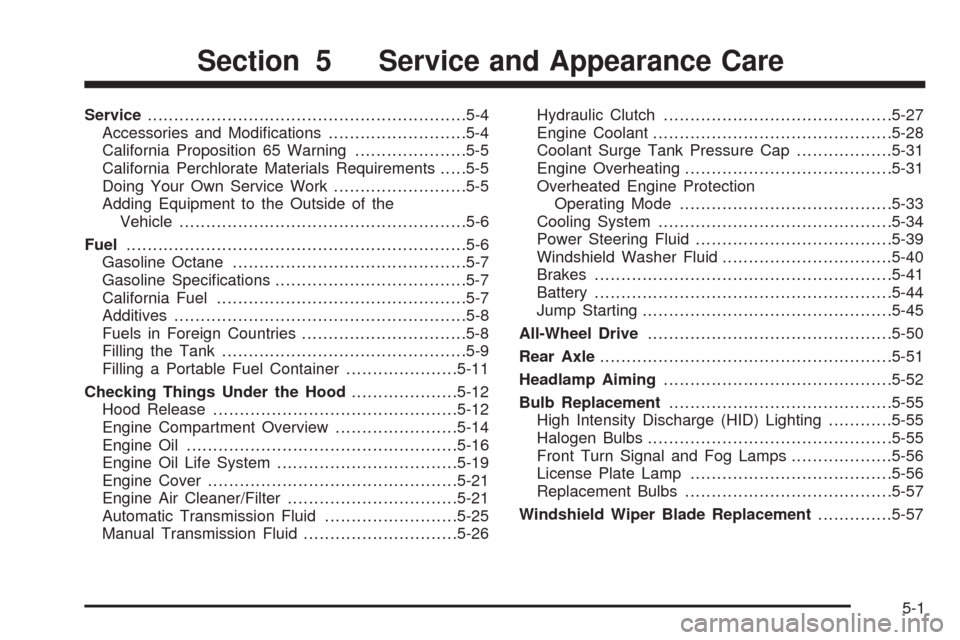
Service............................................................5-4
Accessories and Modi�cations..........................5-4
California Proposition 65 Warning.....................5-5
California Perchlorate Materials Requirements.....5-5
Doing Your Own Service Work.........................5-5
Adding Equipment to the Outside of the
Vehicle......................................................5-6
Fuel................................................................5-6
Gasoline Octane............................................5-7
Gasoline Speci�cations....................................5-7
California Fuel...............................................5-7
Additives.......................................................5-8
Fuels in Foreign Countries...............................5-8
Filling the Tank..............................................5-9
Filling a Portable Fuel Container.....................5-11
Checking Things Under the Hood....................5-12
Hood Release..............................................5-12
Engine Compartment Overview.......................5-14
Engine Oil...................................................5-16
Engine Oil Life System..................................5-19
Engine Cover...............................................5-21
Engine Air Cleaner/Filter................................5-21
Automatic Transmission Fluid.........................5-25
Manual Transmission Fluid.............................5-26Hydraulic Clutch...........................................5-27
Engine Coolant.............................................5-28
Coolant Surge Tank Pressure Cap..................5-31
Engine Overheating.......................................5-31
Overheated Engine Protection
Operating Mode........................................5-33
Cooling System............................................5-34
Power Steering Fluid.....................................5-39
Windshield Washer Fluid................................5-40
Brakes........................................................5-41
Battery........................................................5-44
Jump Starting...............................................5-45
All-Wheel Drive..............................................5-50
Rear Axle.......................................................5-51
Headlamp Aiming...........................................5-52
Bulb Replacement..........................................5-55
High Intensity Discharge (HID) Lighting............5-55
Halogen Bulbs..............................................5-55
Front Turn Signal and Fog Lamps...................5-56
License Plate Lamp......................................5-56
Replacement Bulbs.......................................5-57
Windshield Wiper Blade Replacement..............5-57
Section 5 Service and Appearance Care
5-1
Page 358 of 490
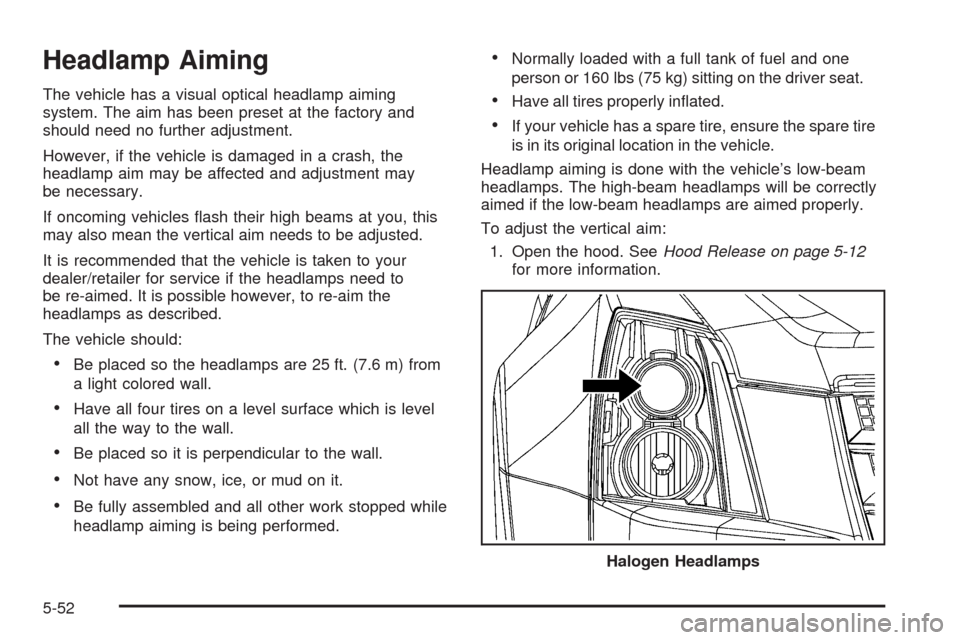
Headlamp Aiming
The vehicle has a visual optical headlamp aiming
system. The aim has been preset at the factory and
should need no further adjustment.
However, if the vehicle is damaged in a crash, the
headlamp aim may be affected and adjustment may
be necessary.
If oncoming vehicles �ash their high beams at you, this
may also mean the vertical aim needs to be adjusted.
It is recommended that the vehicle is taken to your
dealer/retailer for service if the headlamps need to
be re-aimed. It is possible however, to re-aim the
headlamps as described.
The vehicle should:
Be placed so the headlamps are 25 ft. (7.6 m) from
a light colored wall.
Have all four tires on a level surface which is level
all the way to the wall.
Be placed so it is perpendicular to the wall.
Not have any snow, ice, or mud on it.
Be fully assembled and all other work stopped while
headlamp aiming is being performed.
Normally loaded with a full tank of fuel and one
person or 160 lbs (75 kg) sitting on the driver seat.
Have all tires properly in�ated.
If your vehicle has a spare tire, ensure the spare tire
is in its original location in the vehicle.
Headlamp aiming is done with the vehicle’s low-beam
headlamps. The high-beam headlamps will be correctly
aimed if the low-beam headlamps are aimed properly.
To adjust the vertical aim:
1. Open the hood. SeeHood Release on page 5-12
for more information.
Halogen Headlamps
5-52
Page 359 of 490

2. Locate the aim dot on the lens of the low-beam
headlamp.
3. Record the distance from the ground to the aim dot
on the low-beam headlamp.4. At a wall, measure from the ground upward (A) to
the recorded distance from Step 3 and mark it.
5. Draw or tape a horizontal line (B) the width of the
vehicle at the wall where it was marked in Step 4.
Notice:Do not cover a headlamp to improve beam
cut-off when aiming. Covering a headlamp may
cause excessive heat build-up which may cause
damage to the headlamp.
6. Turn on the low-beam headlamps and place a
piece of cardboard or equivalent in front of the
headlamp not being aimed. This should allow
only the beam of light from the headlamp being
aimed to be seen on the �at surface. High Intensity Discharge Headlamps
5-53
Page 360 of 490

7. Locate the vertical headlamp aiming screws, which
are under the hood near each headlamp assembly.
The adjustment screw can be turned with a
6 mm hex socket.
8. Turn the vertical aiming screw until the headlamp
beam is aimed to the horizontal tape line. Turn it
clockwise or counterclockwise to raise or lower the
angle of the beam.
The top edge of the cut-off should be positioned at
the bottom edge of the horizontal tape line.9. Make sure that the light from the headlamp is
positioned at the bottom edge of the horizontal tape
line. The lamp on the left (A) shows the correct
headlamp aim. The lamp on the right (B) shows
the incorrect headlamp aim.
10. Repeat Steps 7 through 9 for the opposite
headlamp. Driver Side Shown
5-54
Page 361 of 490
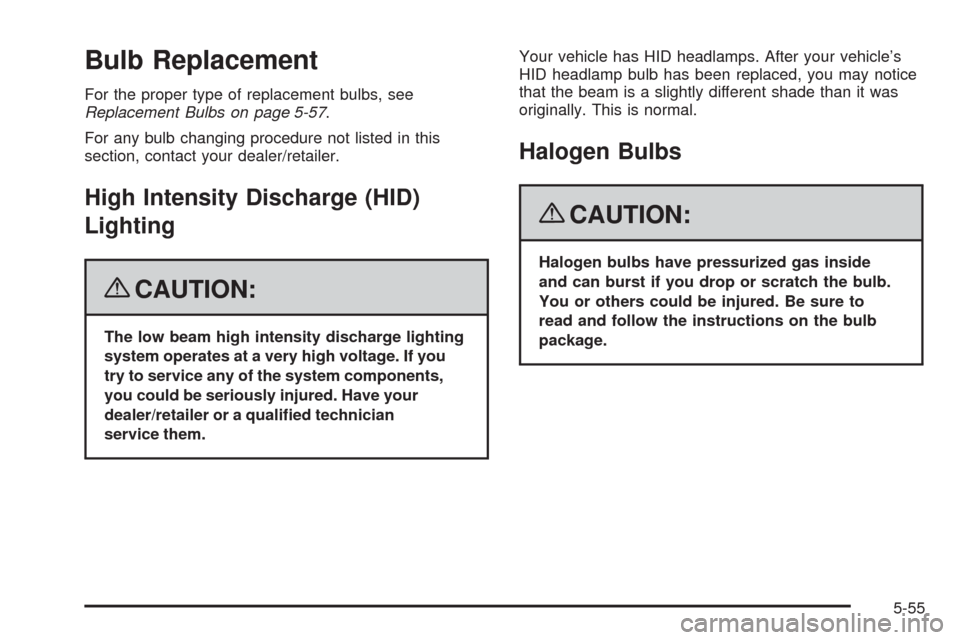
Bulb Replacement
For the proper type of replacement bulbs, see
Replacement Bulbs on page 5-57.
For any bulb changing procedure not listed in this
section, contact your dealer/retailer.
High Intensity Discharge (HID)
Lighting
{CAUTION:
The low beam high intensity discharge lighting
system operates at a very high voltage. If you
try to service any of the system components,
you could be seriously injured. Have your
dealer/retailer or a quali�ed technician
service them.Your vehicle has HID headlamps. After your vehicle’s
HID headlamp bulb has been replaced, you may notice
that the beam is a slightly different shade than it was
originally. This is normal.
Halogen Bulbs
{CAUTION:
Halogen bulbs have pressurized gas inside
and can burst if you drop or scratch the bulb.
You or others could be injured. Be sure to
read and follow the instructions on the bulb
package.
5-55
Page 387 of 490
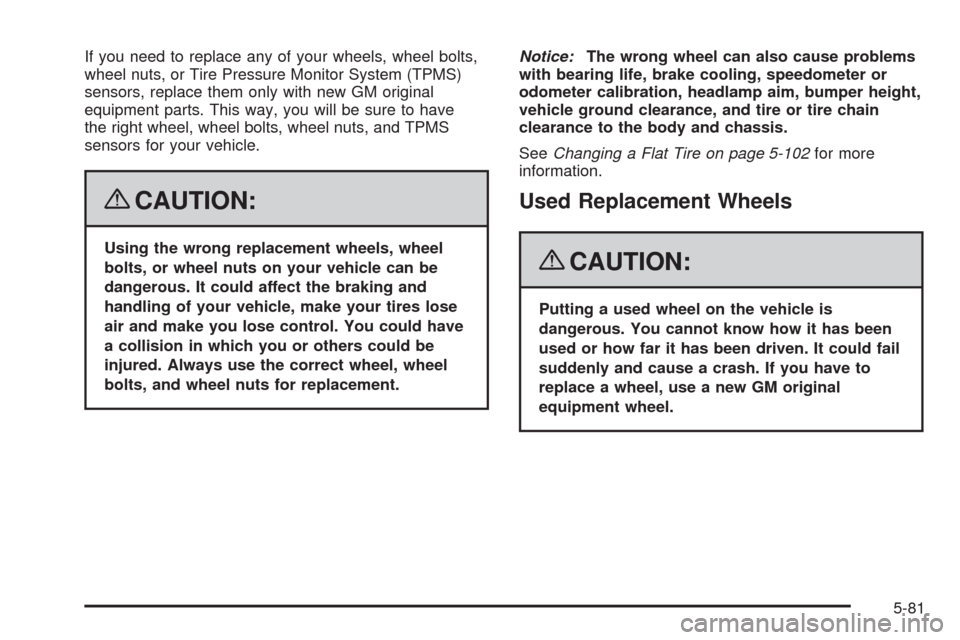
If you need to replace any of your wheels, wheel bolts,
wheel nuts, or Tire Pressure Monitor System (TPMS)
sensors, replace them only with new GM original
equipment parts. This way, you will be sure to have
the right wheel, wheel bolts, wheel nuts, and TPMS
sensors for your vehicle.
{CAUTION:
Using the wrong replacement wheels, wheel
bolts, or wheel nuts on your vehicle can be
dangerous. It could affect the braking and
handling of your vehicle, make your tires lose
air and make you lose control. You could have
a collision in which you or others could be
injured. Always use the correct wheel, wheel
bolts, and wheel nuts for replacement.Notice:The wrong wheel can also cause problems
with bearing life, brake cooling, speedometer or
odometer calibration, headlamp aim, bumper height,
vehicle ground clearance, and tire or tire chain
clearance to the body and chassis.
SeeChanging a Flat Tire on page 5-102for more
information.
Used Replacement Wheels
{CAUTION:
Putting a used wheel on the vehicle is
dangerous. You cannot know how it has been
used or how far it has been driven. It could fail
suddenly and cause a crash. If you have to
replace a wheel, use a new GM original
equipment wheel.
5-81
Page 431 of 490
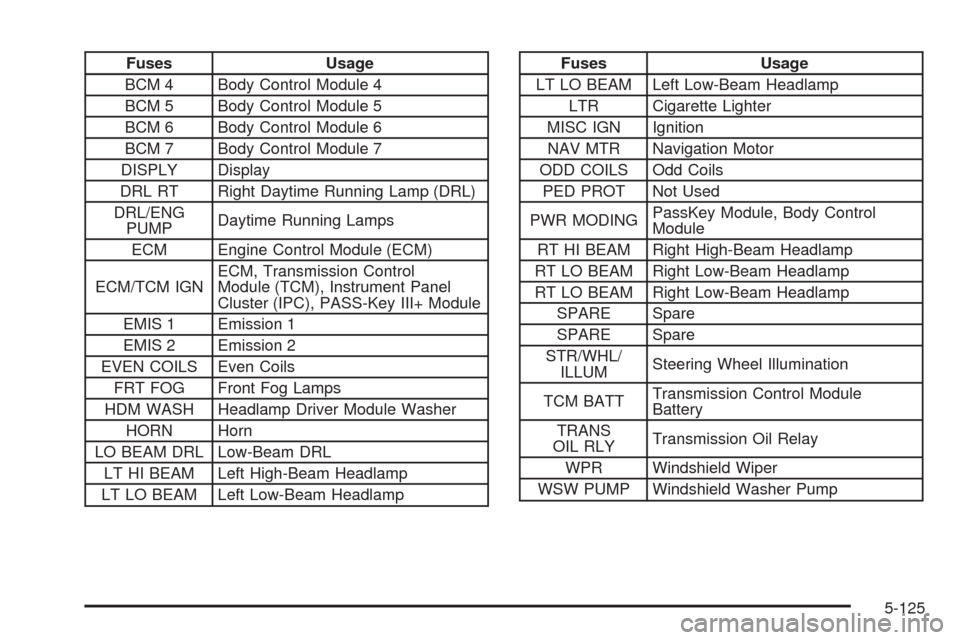
Fuses Usage
BCM 4 Body Control Module 4
BCM 5 Body Control Module 5
BCM 6 Body Control Module 6
BCM 7 Body Control Module 7
DISPLY Display
DRL RT Right Daytime Running Lamp (DRL)
DRL/ENG
PUMPDaytime Running Lamps
ECM Engine Control Module (ECM)
ECM/TCM IGNECM, Transmission Control
Module (TCM), Instrument Panel
Cluster (IPC), PASS-Key III+ Module
EMIS 1 Emission 1
EMIS 2 Emission 2
EVEN COILS Even Coils
FRT FOG Front Fog Lamps
HDM WASH Headlamp Driver Module Washer
HORN Horn
LO BEAM DRL Low-Beam DRL
LT HI BEAM Left High-Beam Headlamp
LT LO BEAM Left Low-Beam HeadlampFuses Usage
LT LO BEAM Left Low-Beam Headlamp
LTR Cigarette Lighter
MISC IGN Ignition
NAV MTR Navigation Motor
ODD COILS Odd Coils
PED PROT Not Used
PWR MODINGPassKey Module, Body Control
Module
RT HI BEAM Right High-Beam Headlamp
RT LO BEAM Right Low-Beam Headlamp
RT LO BEAM Right Low-Beam Headlamp
SPARE Spare
SPARE Spare
STR/WHL/
ILLUMSteering Wheel Illumination
TCM BATTTransmission Control Module
Battery
TRANS
OIL RLYTransmission Oil Relay
WPR Windshield Wiper
WSW PUMP Windshield Washer Pump
5-125
Page 432 of 490
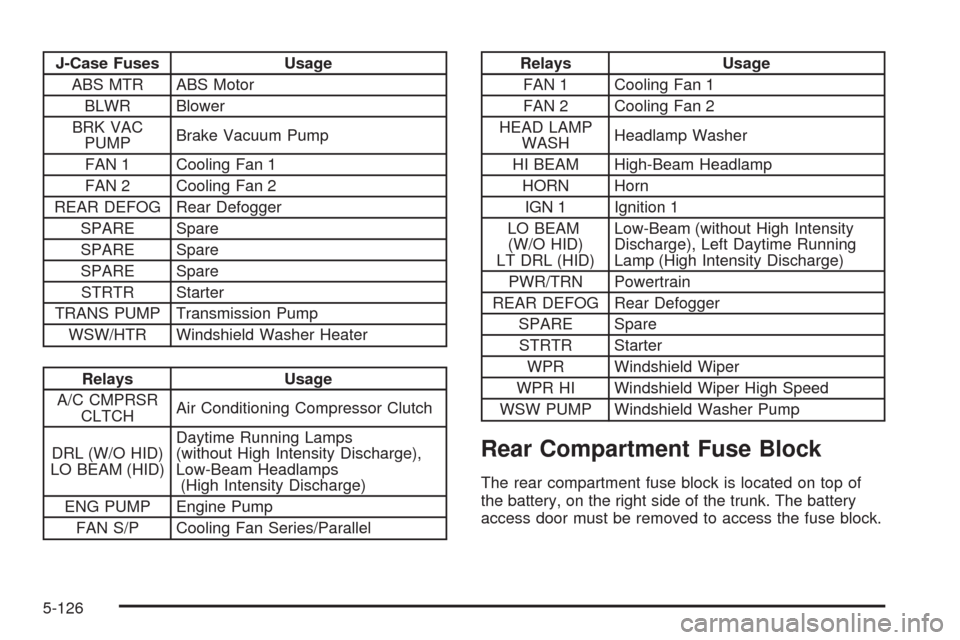
J-Case Fuses Usage
ABS MTR ABS Motor
BLWR Blower
BRK VAC
PUMPBrake Vacuum Pump
FAN 1 Cooling Fan 1
FAN 2 Cooling Fan 2
REAR DEFOG Rear Defogger
SPARE Spare
SPARE Spare
SPARE Spare
STRTR Starter
TRANS PUMP Transmission Pump
WSW/HTR Windshield Washer Heater
Relays Usage
A/C CMPRSR
CLTCHAir Conditioning Compressor Clutch
DRL (W/O HID)
LO BEAM (HID)Daytime Running Lamps
(without High Intensity Discharge),
Low-Beam Headlamps
(High Intensity Discharge)
ENG PUMP Engine Pump
FAN S/P Cooling Fan Series/Parallel
Relays Usage
FAN 1 Cooling Fan 1
FAN 2 Cooling Fan 2
HEAD LAMP
WASHHeadlamp Washer
HI BEAM High-Beam Headlamp
HORN Horn
IGN 1 Ignition 1
LO BEAM
(W/O HID)
LT DRL (HID)Low-Beam (without High Intensity
Discharge), Left Daytime Running
Lamp (High Intensity Discharge)
PWR/TRN Powertrain
REAR DEFOG Rear Defogger
SPARE Spare
STRTR Starter
WPR Windshield Wiper
WPR HI Windshield Wiper High Speed
WSW PUMP Windshield Washer Pump
Rear Compartment Fuse Block
The rear compartment fuse block is located on top of
the battery, on the right side of the trunk. The battery
access door must be removed to access the fuse block.
5-126